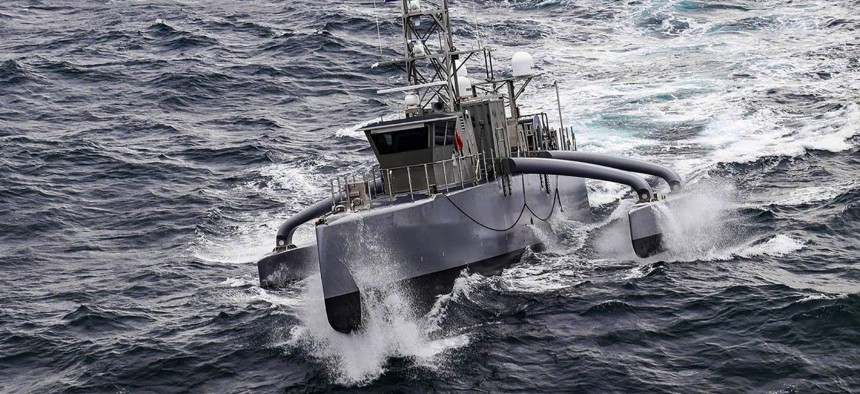
A Sea Hawk medium displacement USV participates in an experiment in 2021. Chief Shannon Renfroe / U.S. Navy
Navy robot ships on a 15-year path to operating ‘at speed and scale,’ CNO says
Adm. Franchetti’s plans to compete with China include better networks, unmanned infrastructure, and a new robotics rating for sailors.
SAN DIEGO, California –“It's clear that we do need a larger navy,” Adm. Lisa Franchetti said on Tuesday, asked about the growing gap between the number of U.S. and Chinese warships. But numbers aren’t everything, the chief of naval operations said.
The People’s Liberation Army Navy is aiming to grow from 370 battle force ships to 435 by decade’s end. But the U.S. Navy needs only to get from the current 310 to its long-sought target of 355, the chief of naval operations said at the AFCEA West conference here.
“It's not about numbers. It's about how you put it all together. It's platforms on, under and above the sea. It's the networks that enable them. It's cyber. It's our work in space. It's work with all the joint force. They are incredible force multipliers,” said Franchetti, who also mentioned efforts to improve ship maintenance and work more closely with allies and partners, particularly in the Pacific.
But Franchetti devoted much of her appearance to the Navy's burgeoning efforts to incorporate autonomous and unmanned surface, air, and undersea drones into its operations. It may take 15 years—three five-year Future Years Defense Program cycles—for today’s experiments to blossom into full-scale operations, she said.
“The actual platform may be unmanned but we also need to set up all the infrastructure, all of the networks, everything that can enable the unmanned technology to actually work with the people to operate it. So in this first FYDP those are some of the things that we're learning and putting into place, these enablers. Then the next FYDP is the actual procurement of those unmanned platforms. And then I think, by the third, that they'll be operating at speed and at scale.”
The rise of uncrewed systems won’t replace traditional shipyards, one industry exec said.
“So the pivot to unmanned systems does not mean that the existing surface-combatant, gray-hull fleet goes away,” said Rob Lehman, chief commercial officer of Saronic, a company that develops autonomous systems. “Small and distributed unmanned systems are intended to enhance the survivability, lethality and relevance of surface combatants for decades to come. So I think the shipyard and shipbuilding discussion is a little bit separated from either big surface combatants or small autonomous systems.”
Lehman said there are some aspects of the surface fleet that can’t be replaced by unmanned vehicles.
“I think it's critical to understand that the surface fleet conducts a broad array of absolutely critical missions, some of which absolutely cannot be replaced by unmanned systems—certainly at this point in time,” he said in an interview ahead of the conference.
To fit today’s strategic needs, drones must be “additive in order to be adopted and enable the CONOPS that the Navy wants to leverage going forward.”
The company is building autonomous platforms around missions such as intelligence, surveillance and reconnaissance, targeting or strikes so the boat can make “dynamic decisions at the edge” instead of just driving from one point to another, said Saronic CEO Dino Mavrookas.
Saronic has two surface drone prototypes—six- and 14-footers—with plans underway to design a larger platform. The goal is to be able to produce up to 200 unmanned vessels per year within the next 18 months and eventually in the thousands, Mavrookas said. So far, only its six-foot surface vessel, Spyglass, is in full-scale production.
“The only way you manufacture autonomous platforms at scale is by combining the hardware and software elements,” he said. “We're building in real mission-level autonomy that enables collaborative teaming and data fusion across platforms to go and conduct missions like ISR, or targeting missions, or kinetic strikes at scale, and the platform's are able to make dynamic decisions at the edge. The definition or the state of the maritime autonomy industry right now, autonomy really means waypoint navigation. So there's a single boat that can drive from point A to point B, without a human controlling it.”
Naval power has traditionally been thought of as “who has the most ships,” Mavrookas said.
“We've had a congressional mandate to get to 355 shifts in our naval fleet for over a decade. And we're at 290 because we can't produce and manufacture ships faster than we're retiring them and taking them out of service,” he said. “We are not going to compete with China on shipyard capacity. The only way you close that gap is augmenting our fleet with thousands of surface vessels” and “building a Tesla-like gigafactory” to produce them.
Franchetti said the Navy is also experimenting with artificial intelligence for maintenance and other activities.
“We're doing this through machine learning and new artificial intelligence tools to help support conditions-based maintenance to free up our sailors for other more important tasking. And we're doing this by using robotics to quickly, accurately and more cost effectively assess the material condition of our seagoing platforms,” she said, in addition to using 3-D printing and other emerging technologies.
The Navy is also looking to establish a new career field, or “rating” for enlisted sailors in robotics, Franchetti announced.
“To build and develop a team for the next generation, a team who has the reps and sets and sensors, platform autonomy and mission autonomy programs and you can provide input and machine learning feedback processes,” she said, indicating that a hint she dropped in December will bear fruit.